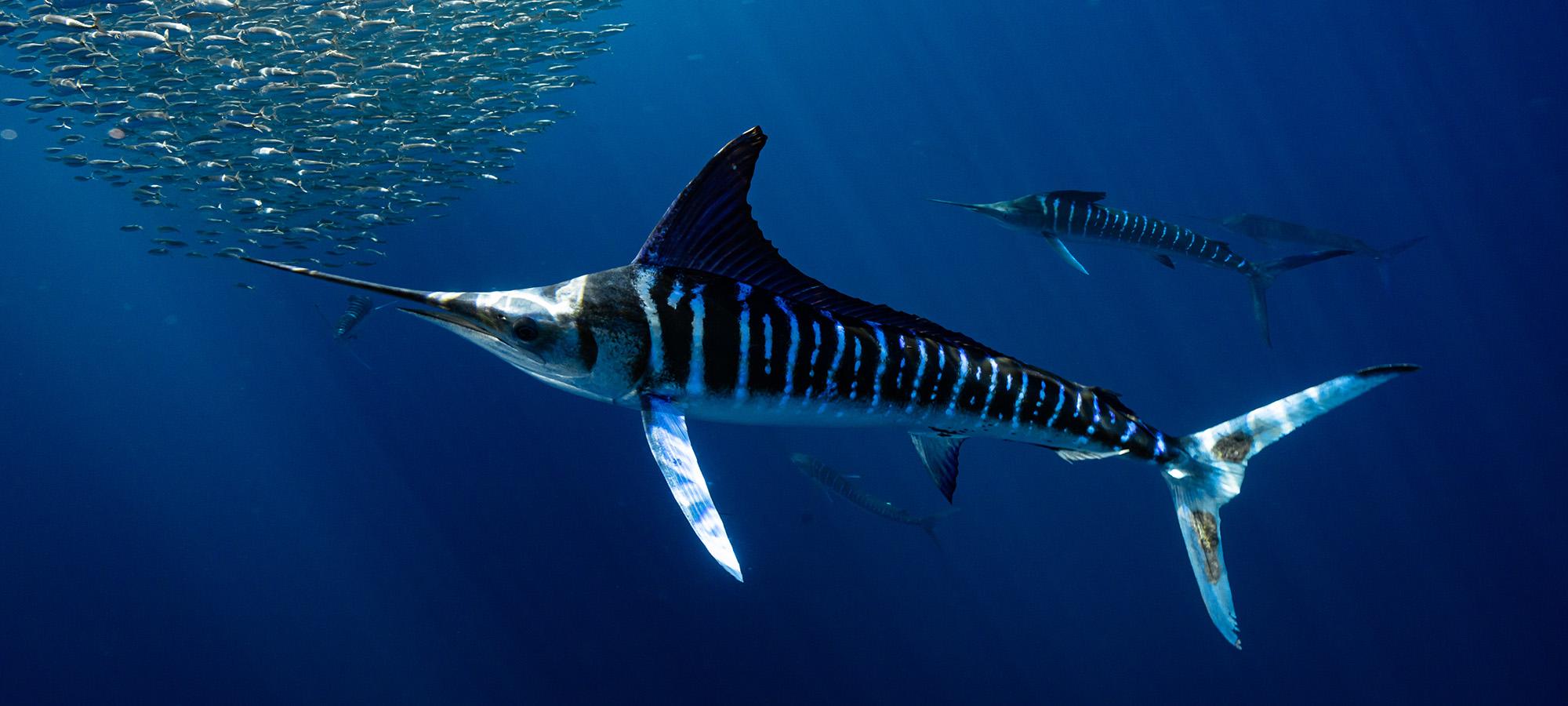Battling for the Future of Striped Marlin During Mexico's Secret Sardine Run
The sun hangs heavy above the panga, its small bow blasting through waves as we shudder along the sheer coast. A thin tarp stretched between the PVC pipes shields us from direct rays, but beyond that we are at the mercy of the Pacific. Between the whipping wind, humming motor and the benches beneath us stuttering with every wave, there's little space for talking. We are quiet as we scan for birds on the sprawling horizon.
We aren’t looking for just any birds (though seeing anything would make for a nice break from the endless blue above and below). Our eyes are peeled for frigate birds. Their feathers dancing above the waves means sardines likely swirl below. And that’s our chance to find the real target: striped marlin.
Unlike South Africa’s world-famous aggregation, Mexico’s sardine run draws few visitors. But quiet waters topside hide the frenzy below, where marlin tag-team with sea lions to tornado these small fish into submission before zipping at lightning speed through the throng.
Witnessing it is an elusive high, but my boatmates and I have come from all over the world for the mere chance to swim near one of the world’s fastest fish. Sören flew from Germany, Alonso from Chile and Tonya from Oregon. My trip from Southern California was a pond hop in comparison. We all met in Cabo San Lucas, shuttled to Puerto San Carlos, and now are bumping along a three-hour boat ride to reach Imposible, the site at which marlin have been seen most frequently this season.
Jay Clue, the bearded owner of Dive Ninja Expeditions, sits on the bench next to me with a sea of tattooed marine life splashed across his calves. I spot an octopus tentacle near a fever of mobulas—or, as he always calls them, “sea pancakes.”
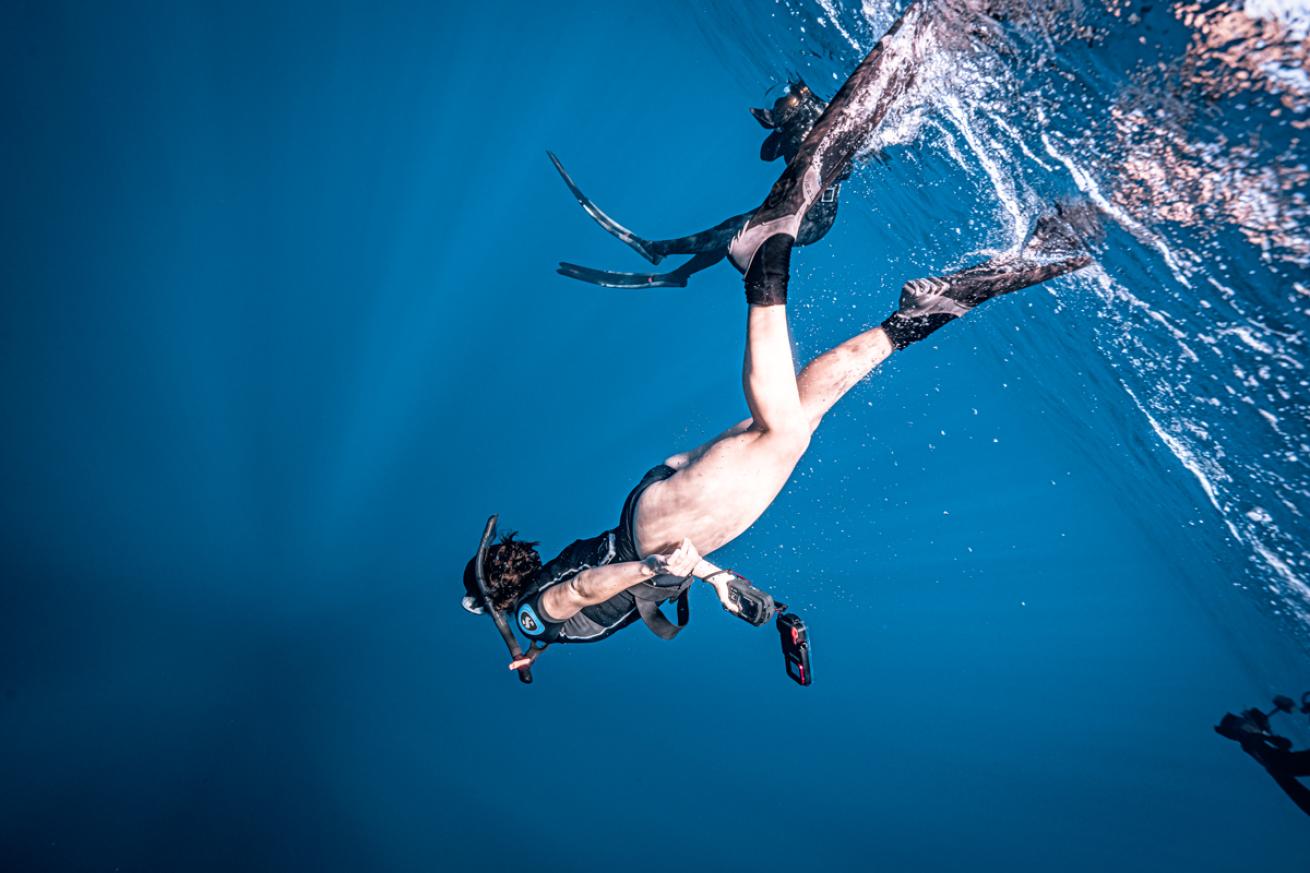
Jay ClueThe author freedives for a better view of the action.
Owning a dive shop was never the plan for this ad man, whose thesis for his master’s degree in design traced the evolution of calligraphy in the Middle Ages to modern graffiti tags. But a stint working at a dive shop in Playa del Carmen gave him the chance to explore Mexico, and Baja’s Pacific quickly drew him away from the Caribbean shores. Former clients began asking him to lead them on expeditions to the remote sites he was posting about on social media. One trip led to another, and he suddenly found himself running a dive tour company.
“I decided that if I was going to open it as an actual business,” he says, “I wanted to...make something that was very different than anything I’d ever seen in the industry. And that is where the idea [started] of trying to build something that could cross tourism with conservation and research.”
His ethos is evident in this striped marlin expedition—we have a scientist on board to conduct research his lab hopes will compel the Mexican government to strengthen marlin fishing protections. Marlin populations are declining worldwide, driving their status as a Vulnerable species on the IUCN Red List.
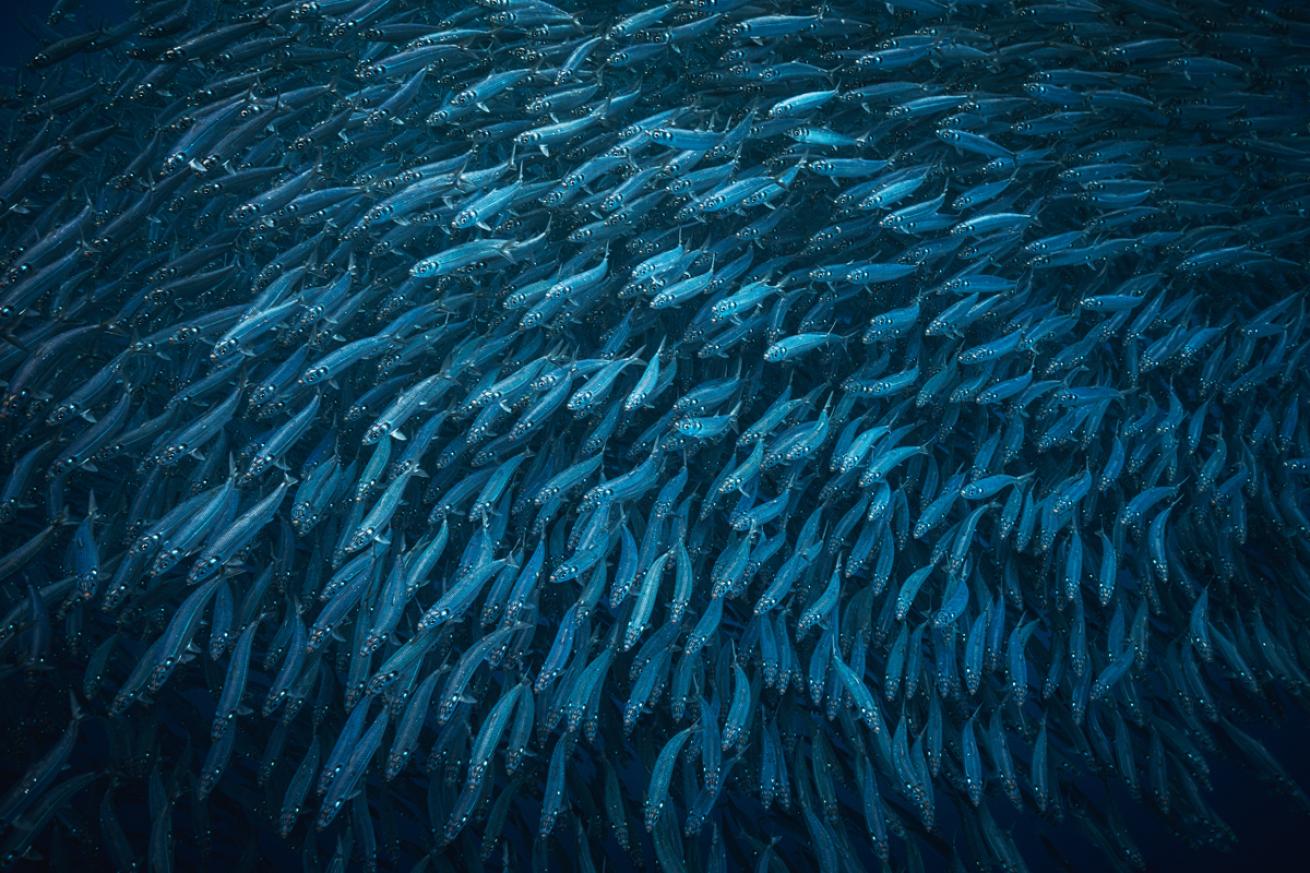
Jay ClueMackerel scatter as a striped marlin charges.
But for Sergio Briones, the Ph.D. student on my trip, to do any of that research, we need to find a marlin. It’s only our first day out, and we’ve already found whales, mobulas and sea turtles, but our headliner has yet to arrive.
Then, suddenly, we’re in luck. A flurry of Spanish explodes from the captain’s radio. I can understand one word through the static, shouted over and over by other captains nearby: “Marlin, marlin, marlin!”
The boat speeds off, our bumpy ride becoming a full roller coaster. Other small vessels materialize on the horizon, a full wake behind them in a parallel race. We jet across the water, donning fins and masks as our Israeli guide Donna Schechter stands on the bow, holding onto a rope like she’s standing on the back of a bucking bronco, looking for the telltale birds. Our panga pulls up upon a semicircle of other small boats, and at Clue’s sign, we slide over the side.
Uncharted Waters
If you’re anything like me, the closest you’ve come to interacting with a marlin is reading The Old Man and the Sea. For the adventurous among us who have had direct contact with a marlin, it’s likely been in the style of Hemingway himself—sport fishing. Sport fishing is big business in Baja Sur. Cabo San Lucas in particular is a marlin sport fishing hotspot, and annual tournaments offering millions in cash prizes are a global draw. Placing an exact figure on sport fishing’s economic impact is difficult. Academic studies estimate between $54 million and $72 million annually, but as the region’s major tourism driver, it’s an important job creator. Sport fishing for marlin is catch-and-release, with a limit of one billfish per fisher per day, but oxygen deprivation, hook damage to the gills and other issues can kill a fish after it is released. This makes it difficult to quantify what a sustainable catch rate is for a catch-and-release fishery.
Marlin snorkeling is nowhere on the public radar. Before my trip, a Google search for “marlin” floods my screen with information about the Miami Marlins. “Marlin fish” turns up video titles like “Caught my FIRST Blue Marlin” and “EPIC Blue Marlin Fishing in Costa Rica.” A marlin sport fishing ad even pops up on the National Geographic species fact page.
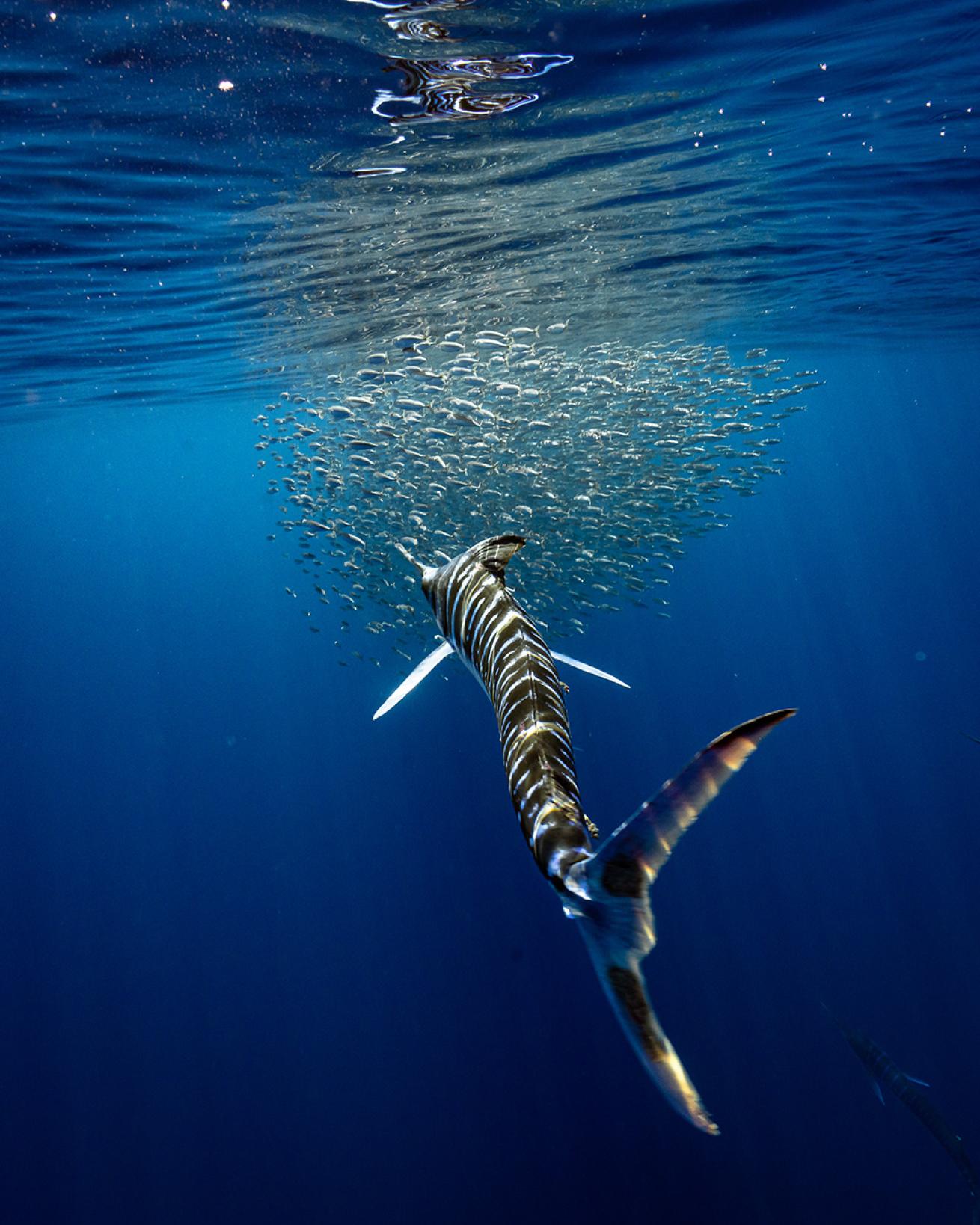
Jay ClueA striped marlin prepares to lunge.
Clue wants to change that. Inspired by research that suggests sharks are worth more as tourism attractions than industrial catch, he is working to build a travel industry that makes marlin worth more underwater than on hooks.
“It’s a crazy experience,” he says. “You hit the water and everything is moving so fast, but you feel like everything slows down for a moment. …There’s this ball of fish—mackerel or sardines—and they’re spiraling around, and then you got marlin coming in, circling them, and the sea lions coming in, and you start to take in what’s actually happening, the marlin taking turns and cutting around, and then all of a sudden rocket up through the baitball, and then they’re spiraling around, waiting, and then they all start coming in hunting at one time, then they’re back off and the sea lions start to come in.”
His idea is catching on, with other shops mimicking his expedition. But the growth spurt has Clue fighting growing pains: Mexico has no rules for governing snorkel interactions like it does for whale sharks, or for balancing the marlin snorkeling and sport fishing industries.
“There hasn’t been enough time to build a solid strategy about how it should work there,” he says. My group will see that for ourselves soon enough.
In a bid to push for additional marlin protections, Dive Ninja is piloting a partnership with local scientists. The shop is working with Dr. Rogelio Armas, of the National Polytechnic Institute of Mexico, who discovered the first striped marlin larvae in the Sea of Cortez in 1992. He believes marlin migrate to Baja Sur to spawn, as his sampling has found individual larvae as far apart as 20 nautical miles off of Cabo San Lucas to the mouth of Magdalena Bay—a potentially sprawling spawning ground frequented by sport fishing charters. Armas wants to discern if, when and where marlin are spawning in the region to push for data-driven fishing restrictions to protect the marlin from excessive fishing whether that’s sport, longline, or otherwise.
“We need to protect these spawning areas because the spawning biomass,” or plankton, is the basis of the oceanic food chain, he says.
Here’s the thing: a marlin larva is a few millimeters in size. The ocean is…a lot bigger. Dive Ninja records the sites of all marlin encounters and the water temperatures, which helps the shop and scientists get a better sense of where they congregate. But nature evades precise predictions, and even finding a marlin doesn’t guarantee finding larvae. Zooming around for hours a day, days at a time, in hopes of finding a marlin so the water can be sampled in hopes of finding a planktonic speck requires more boat fuel than an academic institution can cover.
Dive Ninja “brings the boat and the tourists, and I go too with my nets and microscope,” says Armas.
Science at Sea
As the bubbles clear away from my mask, I swim away from the boat through the impenetrable blue. Slowly, a baitball materializes ahead, shimmering like a desert mirage. I fin as close as I dare, not wanting to disturb the feeding frenzy, and afraid I will accidentally get impaled by marlin if I do.
I come upon a bloody dance. The gray mackerel cloud twists up and down, changing shape like campfire smoke on a windy night to avoid the sea lions stalking their perimeter. Every few minutes, a circling sea lion juts into the mist. The fish contort around them, leaving only water between their teeth. The sea lion cyclones about before having another go, this time snagging a fish in an explosion of silver scales like the world’s saddest confetti.
I will myself to look away from the mesmerizing ballet in front of me to stare down into the blue void below. Sea lions and marlin often work as a team to feed on a baitball: One predator will circle below, keeping the baitball pinned at the surface, while the other eats. Since these mackerel aren’t dropping down to escape, there could be marlin nearby.
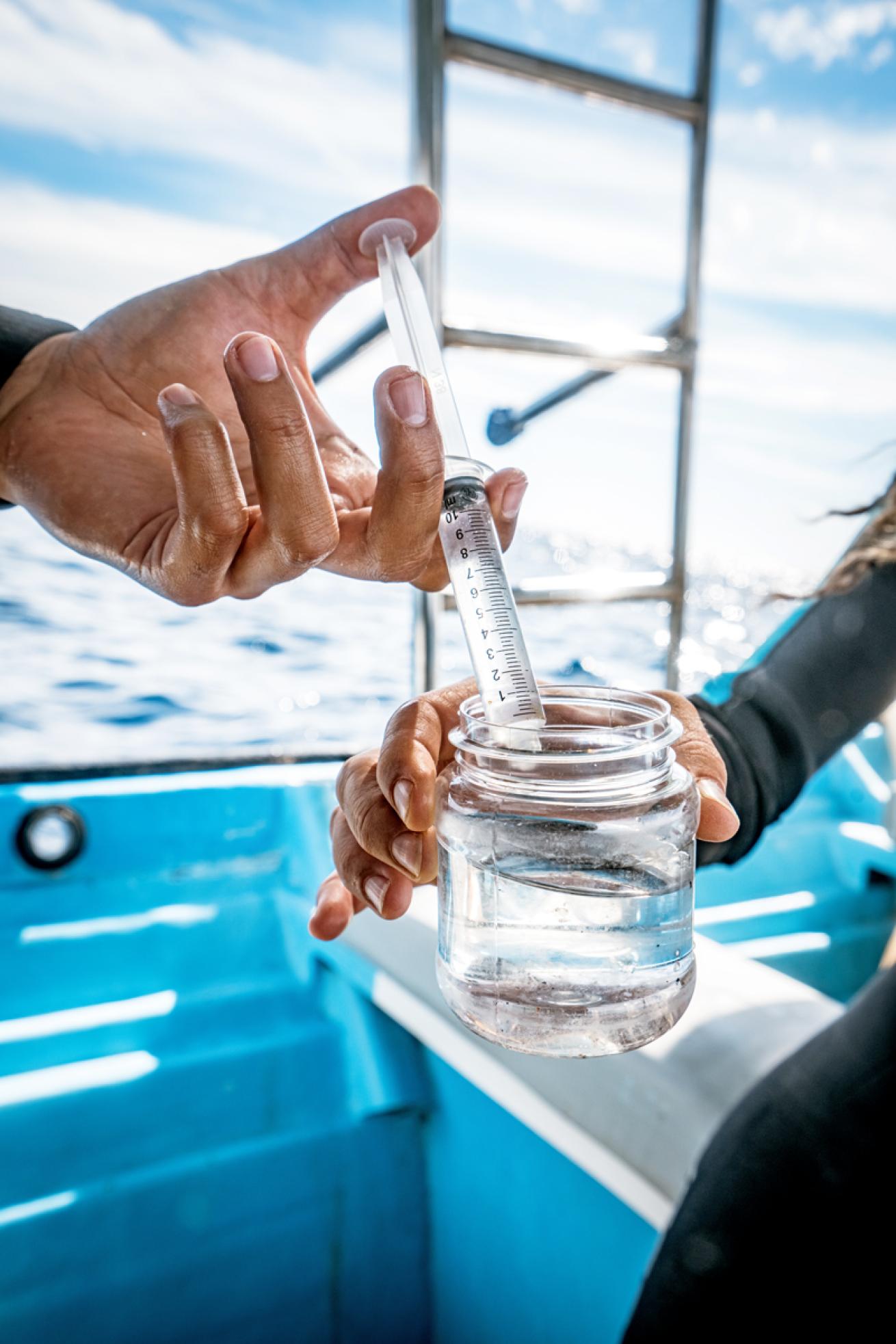
Jay ClueBriones preserves organisms in a sample with diluted formaldehyde.
I strain my sight again and again until—there. Was that it? It is. A marlin. I see its long spear cut through the water, fins arched, and a bolt of fear jolts my stomach. I came all the way here for this encounter, yet seeing this massive form directly below, knowing it can hit 80 miles per hour and be near me any second if it so chooses, sends nerves fizzing through my core. I breathe deeply through my snorkel. It drops away. Then returns. Or perhaps there are multiple marlin? I cannot tell, but pay extra attention to ensure I do not drift over the baitball. I’m bigger than a marlin target—my size likely indicates I am another predator here to feed on the baitball—but it’s unwise to put yourself on top of their bull’s-eye.
Hovering below me, a BBC videographer on scuba trains their cinema-quality video camera toward the frantic fish. The team has been here for weeks, Clue tells us, to capture a documentary segment on the frenzy. Like us, they’re waiting for the money shot, that moment when the marlin below sends an electric charge through its stripes, glowing neon blue before blasting through the sea. Nobody is sure why they peacock before dashing into a baitball. It could be a signal to other marlin that they are about to charge, so they can avoid running into each other. Another theory is that it’s a marine take on flushing from exertion. Whatever the reason, it’s stunning—but we don’t get to see it today. The two or three marlin dropping in and out of sight eventually fade away completely.
Once all of us have flopped back onto the boat, Briones tosses a long net over the edge of the boat. A student in Armas’ lab, he is here to sample the water for larvae anywhere we encounter marlin. The net, which looks like an enormous butterfly net, has a filter and jar screwed onto the end. Any potential eggs or marlin larvae caught in the jar during its 10-minute drag behind the boat are sent to the lab for sampling. Schechter runs the clock, telling Briones when to pull the net aboard. As he holds up the see-through container, we stare at the ocean concentrate. Does he hold in his hands a secret of marlin reproduction?
“They have found one larva in this area, so we keep looking,” Briones says. He pulls his neck gaiter, screen printed with marlin and mahi-mahi, back over his dark ponytail and pierced ear as we turn our bow back toward our home bay.
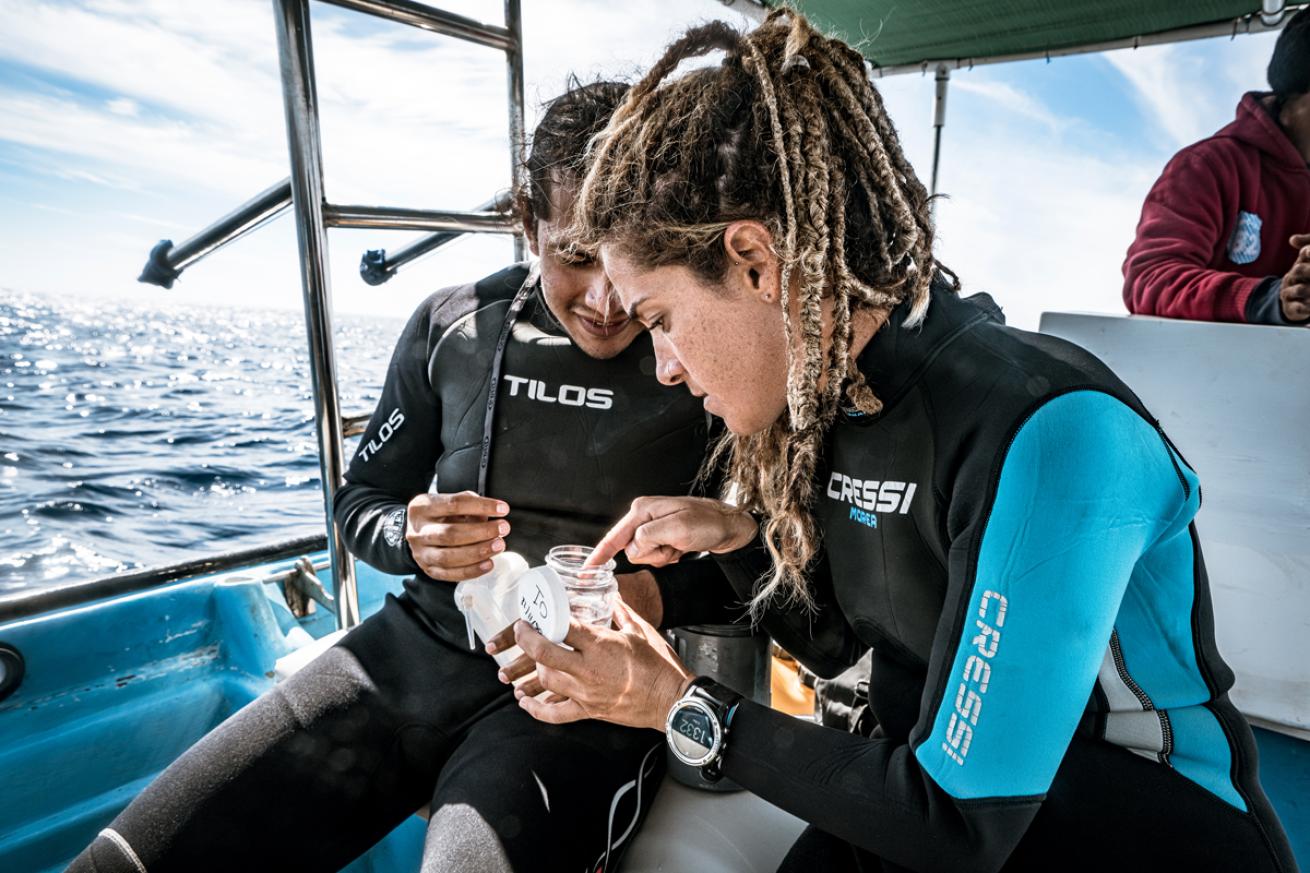
Jay ClueSchechter, right, discusses a water sample with Briones.
Uneasy Bedfellows
The next day, we have an encounter like none Dive Ninja has ever experienced before.
Meditative hours pass as we make our way south. Once near Imposible, we cut wide, solitary circles. Most of the other tour vessels went north today, and the BBC team is on a baitball too far offshore for us to make it comfortably with our gas supply.
We catch our lucky break in the early afternoon. One of the few boats in the area has found a baitball where marlin are actively feeding. Full-scale commotion breaks out on board as we all toss off jackets and shove on fins. I put my feet over the edge of the boat, watching them bop above the water as we skip across the surface.
“Go, go, go, go, go, go, go!” Schechter shouts, and we launch ourselves into the sea.
I see hazy movement straight away, a dark and darting shadow. A nervous fizz bubbles through my veins at the sight. Here it is.
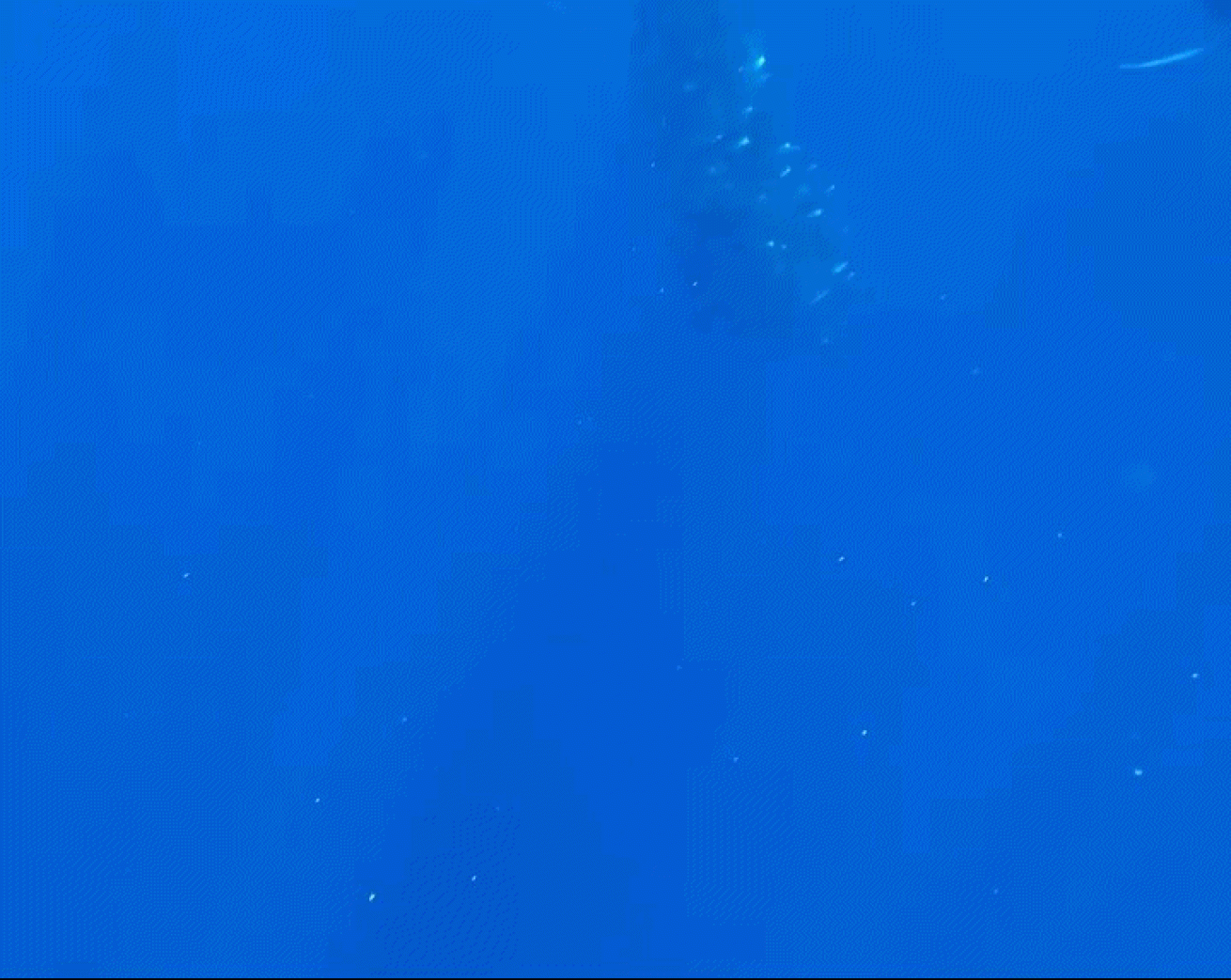
Alexandra GillespieA marlin darts through a small baitball just below the surface.
A breathtaking marlin becomes clear as it arcs past ahead of me, just below the surface. He turns, shines blue, and at unbelievable speed darts through the small gaggle of fish in front of him. One moment he is on my left, the next far to the right. He misses.
Another marlin paces below, waiting its turn. The one nearby circles back for another go, scales shining in the shallows’ filtered light. His sail-like fin deployed, he cuts through the water with grace. Then—zip. He’s through the ball again, and this time he succeeds. I watch a cloud of scales filter slowly down in his wake.
Then, all of a sudden, the baitball drops. Down, down, down, and it’s out of sight. With no sea lion buffer car, the two marlin couldn’t keep their prey pinned.
My heart is pounding. The entire encounter lasted a minute, maybe, and my entire body is as electrified as a charging marlin’s stripes.
Beaming and dripping, I haul myself back on the boat. I look back at the site only to see one of the marlin I’d been swimming with 30 seconds earlier leaping and twirling through the air, snagged on a sport fisher’s hook. “Marlin!” a man cries in victory. The scales I watched under the soft filter of water now flare in direct sun.
While our faces were glued in the water, a sport fishing boat pulled up on the same baitball and deployed their fishing gear—without waiting for us to get out of the water. The marlin was hooked before I even got back in the boat.
Our captain is furious. He steers the boat straight toward the sport fishing vessel, spitting rapid Spanish at their captain. As with the radio chatter earlier, I only catch one word over and over: Gente, gente, gente! “People, people, people.” There were people in the water!
We’re gone before they can respond—and before we can see what happened to the marlin.
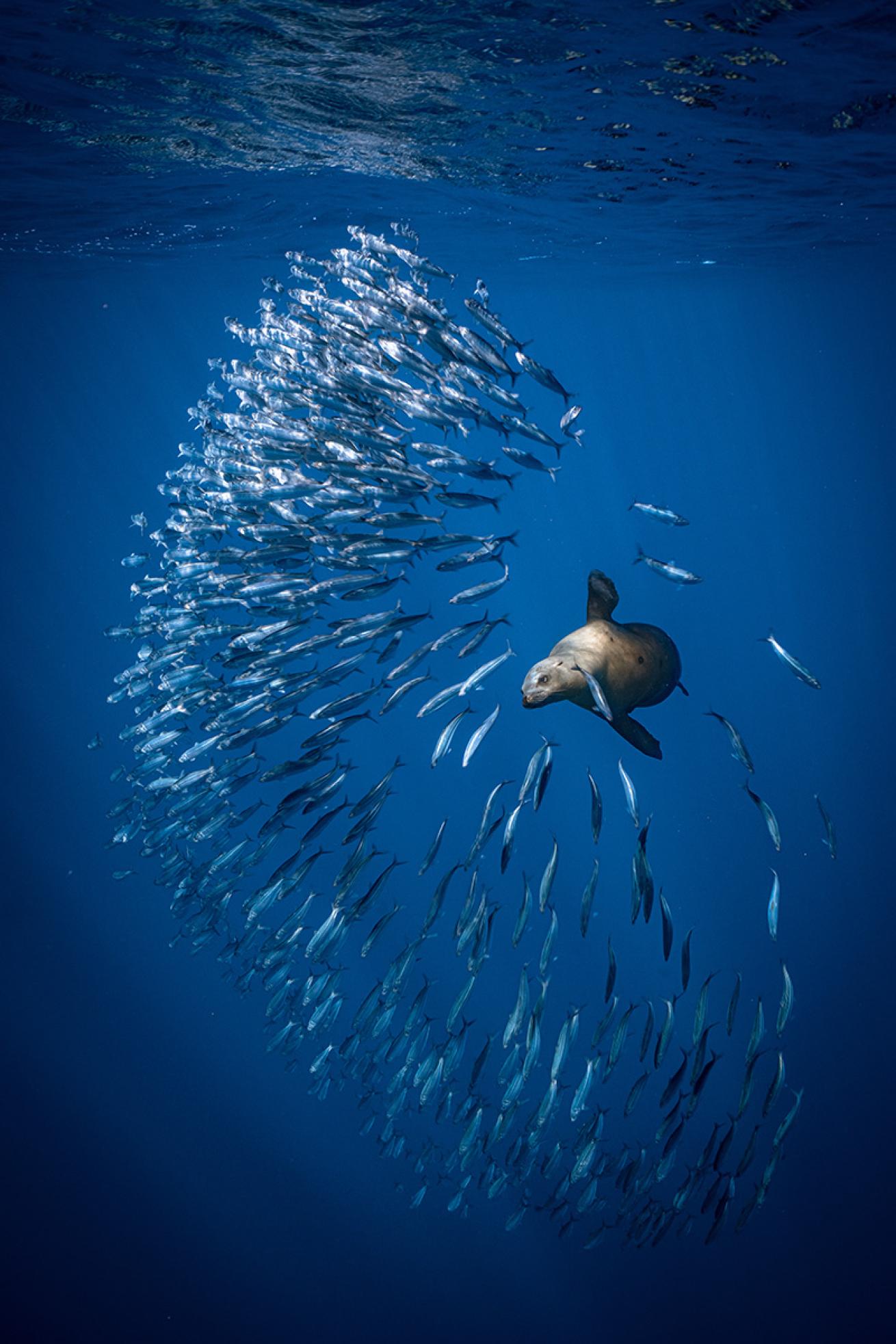
Jay ClueA sea lion works a small baitball.
Laid bare are the difficulties Dive Ninja faces in building this new brand of eco-tourism. For all of its benefit—lower impact on marlin while providing jobs similar to the existing sport fishing industry—any transition will be slow. “They’ve been sport fishing out here forever,” says Clue. “We’re the newcomers.”
And, ultimately, snorkeling is unlikely to replace sport fishing entirely. “People like to say, ‘Oh, why don’t we all just swim with the marlin,’” Briones says as we follow the GPS back to the marlin encounter site for a water drag. “Well, you come to swim one month a year. But we need to eat all year.”
Protected areas like the one Armas’ team hopes to advocate for could be a solution: Snorkelers would use no-take areas separated from sport fishing. But that possibility is well down the road, so coexistence must rule until then, an uneasy balance when all of the boats feel pressure to deliver promised experiences to paying customers who traveled across the globe to be there.
Clue is ready to walk the long road he’s building one brick at a time. Dive Ninja is a living example that conservation in business is more than “‘we don’t use plastic’ or ‘we give $2 to this,’” he says. “Hopefully other people see that if we’re successful, and we’re setting the bar higher and higher, they can say, ‘Wow, we could do that too.’”
The ride home is so choppy I feel like dice rattling in a Yahtzee cup. I am convinced the entire time that my skeleton is going to splinter into pieces, that my skin is the only thing stopping my bones from clattering into the wake. Occasionally we smack down so hard against a wave I imagine my flesh will liquefy and every part of me will scatter.
“When you’re doing it, you’re like, ‘What am I doing?’” says my fellow traveler Sören at dinner that night. “But it’s not the boat ride that sticks. It’s the marlin.”
And you know what? He’s right. Even when I close my eyes now, months later, I see the supercharged glow of silver scales surging electric in the blue, blazing feet before my eyes, before slicing through the water.
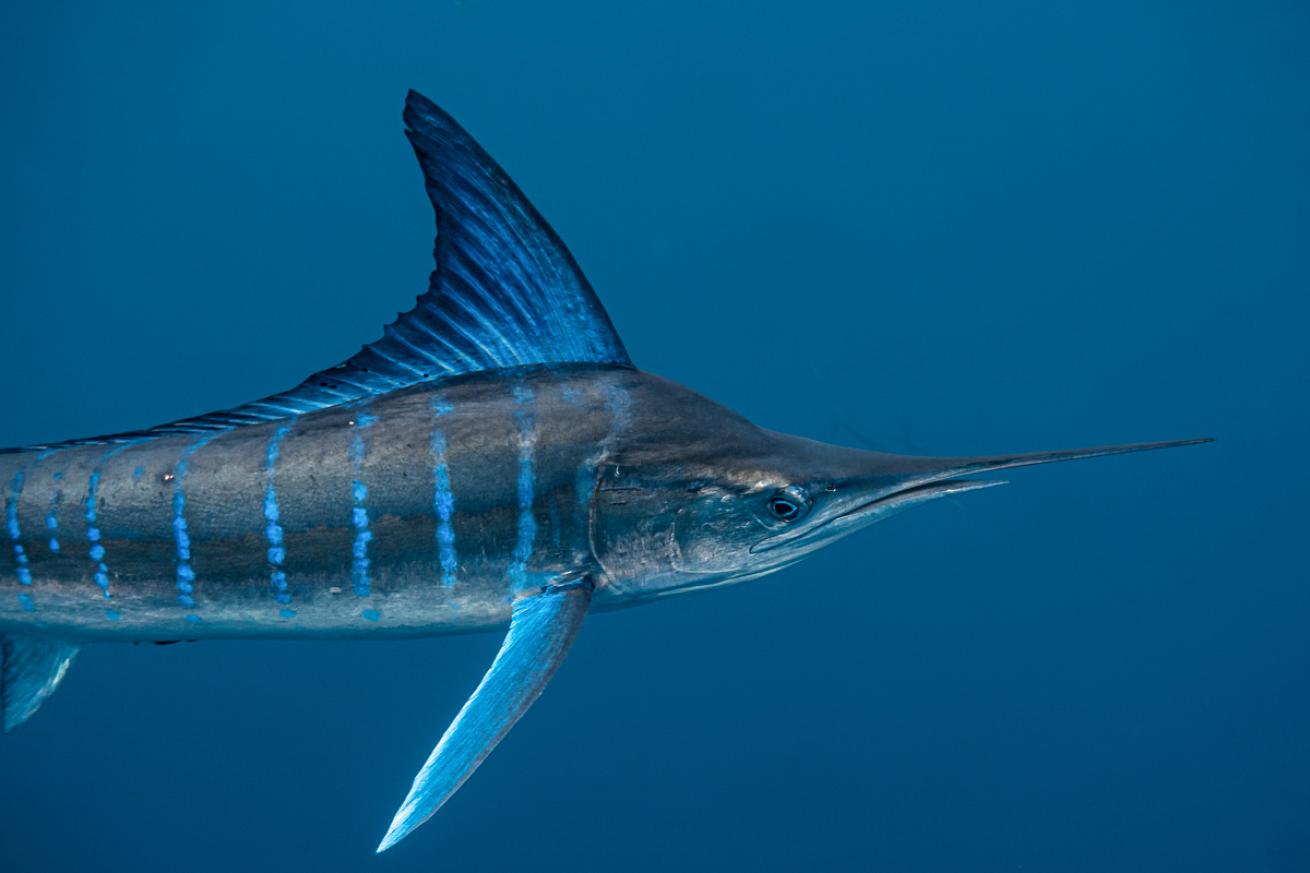
Jay ClueA stripped marlin soars past.
Need to Know
Operator: Dive Ninja Expeditions
When to Go: Expeditions run from early October until the first week of December.
Conditions: Water temperatures at this time of year are in the high 70s to low 80s. Visibility can top 100 feet.
What to Bring: A 5 mm wetsuit is recommended. Freediving fins are best for swimming near the surface; a neck gaiter, sun hat, sunglasses and jacket are all helpful exposure protection on the boat. A dry bag is useful for keeping any electronics or clothing dry, as the inside of the boat will get wet when people get in and out of the water throughout the day. Bring dry layers for the boat ride to land at the end of the day. Related: What to Pack for an Extreme Snorkel Trip
Transportation: Expeditions begin and end at Dive Ninja’s shop in Cabo San Lucas. A shuttle is provided between Cabo San Lucas and the expedition home base in Puerto San Carlos.
Accommodations: Magdalena Bay lodging is included in the expedition price. Dive Ninja guests staying in Cabo San Lucas the night before or after the trip can book a discounted stay at Cabo Vista Hotel.
Airport: Los Cabos International (SJD)
COVID Travel Requirements: Travelers do not need a test to enter Mexico or return to the United States.
Price: $2,150 (30 percent of profits are donated to striped marlin conservation and research work)

